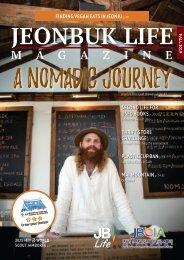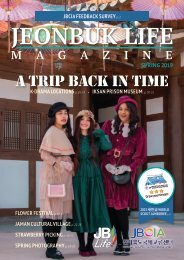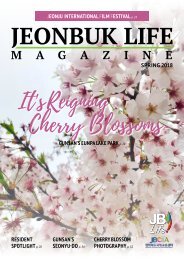Create successful ePaper yourself
Turn your PDF publications into a flip-book with our unique Google optimized e-Paper software.
Home is where the
Parasiteis
THE HOUSE BUILT IN JEONJU
The aspirational lifestyle of the rich and famous is
represented by the massive, modern contemporary home
of the Parks. With the head of the family being a wellheeled
architect himself, the home is carefully designed
with comfort and visually pleasing aesthetics in mind.
The real stars in the film are the two contrasting abodes with hidden meanings
Words byDIANNE PINEDA-KIM
Poster by NEON ENTERTAINMENT
The vertical lines, the endless staircases, the
enclosures and open spaces all throughout
the Academy Award-winning masterpiece,
“Parasite” are not accidental elements simply
conjured by film connoisseurs. This motif shown
through the stark contrast in the two leading
families’ homes is undeniably visible from
beginning to end, amplifying the
movie’s deeply rooted message:
the huge chasm between
the rich and the
poor.
THE DARK
BASEMENT
The viewers were first introduced to
the banjiha or semi-basement home that
is, in reality, proof of the dire living situations
of financially challenged Koreans who were forced
to survive in almost uninhabitable homes usually
found entrenched deep in the heart of Seoul. This is
the Kim’s family home, which was described by the LA
Times as “real spaces of desperation and dreams,” and
“a semi-basement apartment with scant sunlight and
dirt-cheap rent, that for many South Koreans is a last
resort, a rite of passage or a low-slung pit stop on the
way to something better.”
“Banjiha is a space with a peculiar connotation....
It’s undeniably underground, and yet you want to
believe it’s above ground,” acclaimed director Bong
explained. “There’s also the fear that if you sink any
lower, you may go completely underground.”
In the film, this mansion is the epitome of dreams that came true
and the testimony that one has finally “made it.”Interestingly,
this was built from scratch at an empty lot location in Jeonju.
The city government has announced that they will soon rebuild
parts of the home and open this location to tourists and fans of
the film.The minimalist, wide, and airy design veered away from
the cluttered mess of the banjiha. This design reveals a not-so
startling truth: fresh air and space are valuable commodities
and luxuries only the rich can afford.
Production designer Lee Ha Jun designed a giant open-floor
plan with an uninterrupted expanse, and the house appears
to have that alluring beauty which lets in natural light. “Mr.
Park’s house is an outdoor set built in consideration of the
sun’s direction. The sun’s direction was a crucial point of
consideration while we were searching for outdoor lots,”
Lee told Indiewire. The designer specifically chose Jeonju
for its harmonious combination of the cosmopolitan city
vibe and tranquility of nature.
Bong explained, “I had to really meticulously design the house
itself. It’s like its own universe inside this film. Each character
and each team has spaces that they take over that they can
infiltrate, and also secret spaces that they don’t know.”
There’s an old adage that optimistically says, “Home is
the starting place of love, hope and dreams.” But
for Bong and Lee, the home is also a glaring
reality that “reflects the class difference
between elevated areas and lower
ones as appearances change
A
from the rich house to
vicarious
the semi-basement
look at how the
neighborhood.”
family of four squeeze
their sweaty bodies into
the cramped, moldy, critterfilled,
dark, and narrow dwelling will
be enough to give you a slight feeling of
claustrophobia.
The Kims are the downtrodden anti-heroes who will
eventually devise clever ways to infiltrate another
house—one that is worlds apart from their own.
41















